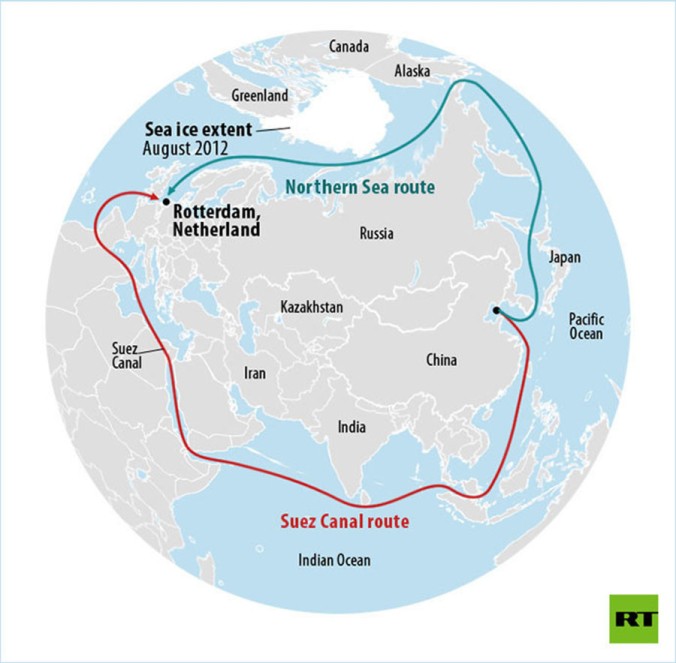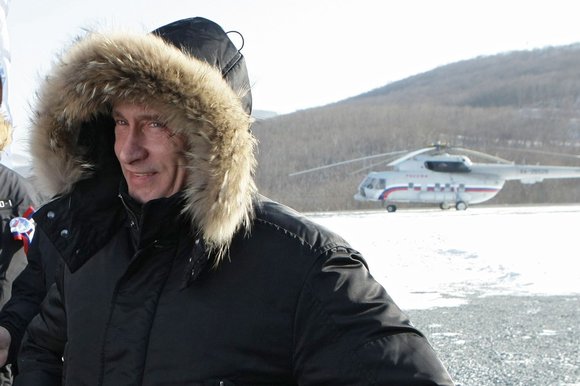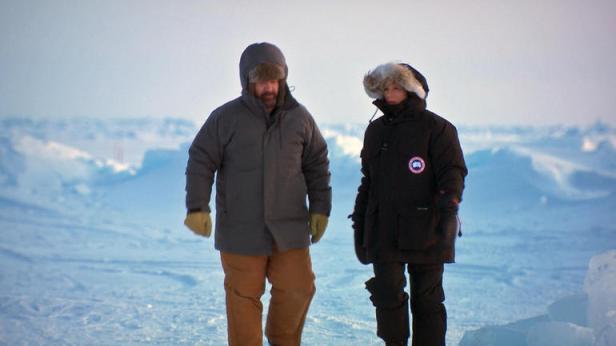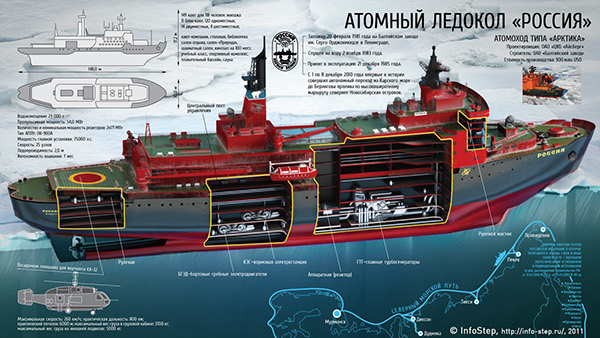
http://www.defenceforindia.com
ACCORDING TO A 7.6.15 ARTICLE ON NEWSWEEK.COM “THE ARCTIC, WHICH COVERS EIGHT PERCENT OF THE EARTH’S SURFACE, IS WARMING TWICE AS FAST AS THE REST OF THE PLANET. WITH ALL THAT ICE MELTING, THE REGION IS IN DANGER OF BECOMING A 21ST-CENTURY WILD WEST-A FREE-FOR-ALL FOR POWER AND RICHES OPENING UP AT THE TOP OF THE PLANET.”
A Council on Foreign Relations (CFR) report released in May 2015 said that:“The Arctic is disappearing so fast that the U.S. Navy predicts the entire Arctic Ocean may be totally ice-free in summers by 2050, with ships able to traverse the top of the North Pole.
This will be the new Arctic Seaway.
And why might it lead to a new cold war? Because the new Seaway will have access to oil, natural gas and mineral resources worth trillions of dollars (almost as much as the entire U.S. economy/Source: 60 Minutes; 10.2.2016) and Russia encompasses about half of its coastline; over 10,000 miles.
Once again, according to the CFR, “The most recent Circum-Arctic Resource Appraisal, conducted in 2008 by the U.S. Geological Survey (USGS), estimated that nearly one-quarter of the earth’s undiscovered, recoverable petroleum resources lie in the region: 13 percent of the oil; 30 percent of the natural gas; and 20 percent of the liquefied natural gas. More than 80 percent of these are thought to be offshore. ‘The extensive Arctic continental shelves may constitute the geographically largest unexplored prospective area for petroleum remaining on Earth,’ said the USGS. The study did not account for nonconventional resources like oil shale, tar sands, or gas hydrates.”
Could Russia cause mischief by holding the Arctic Seaway ransom for European and Asian markets who want to use the Seaway for transit?

thesundaytimes.co.uk
The reason why the Seaway is so important for European and Asian markets is because the calculated shipping distance between Asia and Europe using the Arctic Seaway is 37% shorter than using the the southern route via the Suez Canal, representing approximately 28 days. Or 7,200 nautical miles between between the ports of Yokohama and Hamburg. (Source: Financial Times 10.21.2016)
By shortening their shipping route, traders in the the North Pacific and North Atlantic will reduce fuel consumption, cause less carbon emissions, deliver goods faster and make more profits than the traditional routes through the Suez and Panama Canals.
In fact Russian President Vladimir Putin says he wants the Bering Strait, between Alaska and Russia, (55 miles at its narrowest point) to become the next Suez Canal. (Source: Newsweek.com 7.6.15)
On 10.2.2016 60 Minutes aired a segment entitled “The Arctic Frontier” by correspondent Leslie Stahl who reported on her recent trip to the Arctic.
She said her story was not “about climate change (but) a story about the competition for…riches. The Russians, for instance, have already amassed a major military presence in the region.”

Nevertheless, Ms. Stahl, reported that the fractured thinning ice where it was thick enough to support a U.S. base camp of scientists and naval personnel moved as much as eight-to-nine miles a day.
She reported that the Russians conducted a military exercise in the Arctic last year involving 40,000 troops, 41 warships and multiple aircraft. While it was their own territory, the exercise was not announced.
This was corroborated by the the U.S. Department of State International Security Advisory Board in a report dated 9.21.2016: “In March 2015, an exercise in the Barents Sea involved 41 warships, including 15 submarines, 38,000 ground troops, and 110 aircraft. President Putin has personally observed a Northern Fleet exercise. Aerial surveillance missions, some of which penetrated into, or came close to, the air space of neighboring nations or were flown in Air Defense Identification Zone (ADIZ) areas without transponders operating, have also increased.
Submarines from the Northern Fleet have conducted operational patrols from their bases in the region on a scale rarely seen since the Cold War. These have not been confined to the ‘bastion’ but have included patrols through the so-called Greenland-Iceland-United Kingdom (GIUK) Gap into the North Atlantic. These activities reflect the generally more ambitious scale of Russian military, and particularly naval, operations but have not restored the levels of activity maintained prior to 1991.”
Newsweek ran a cover story on 7.17.16 entitled “In the Race to control the Arctic, the U.S. Lags Behind.”
In its story, Rob Reiss wrote that: “It’s a new kind of geopolitical cold war, and the U.S. is in danger of losing. ‘We’re not even in the same league as Russia right now,’ Coast Guard Commandant Paul F. Zukunft says. ‘We’re not playing in this game at all.’ In the Arctic, the only way to move around on the surface of the sea in even thinner summer ice—to do search and rescue, lead other naval or commercial ships, or conduct heavy research—is often on icebreakers.”
The U.S. has only two, both old and “there’s no money for new icebreakers,” reports Fran Ulmer, chair of the U.S. Arctic Research Commission. Ulmer says an icebreaker can cost up to a billion dollars, and “it takes years to get one built. Russia operates 27 icebreakers, and China, which is not an Arctic nation but has aspirations in the area, will have two by next year.”
Secretary of the U.S. Navy Roy Mabus was on a submarine in the Arctic for five days while Ms. Stahl was there and said: “Our responsibilities are changing as the ice melts and the climate changes.”

Russian Icebreaker, “Russia.”
So will the Arctic nations (Canada, U.S. (Alaska), Norway, Denmark (Greenland), Iceland, Sweden and Finland) let Russia control Arctic shipping, particularly since Russia’s Deputy Prime Minister has said that “the Arctic is part of Russia?”
Mead Treadwell, the 11th Lieutenant Governor of Alaska from 2010 to 2014 and the former Chair of the U.S. Arctic Research Commission, serving from 2006 to 2010, wrote in the 4.8.2015 Harvard International Review that “some U.S. reluctance to moving forward in the Arctic comes from the status quo.
As the U.S takes the chair of the Arctic Council… it wants to focus on fighting climate change; simultaneously promoting new business in this newly accessible ocean might come off as counter to the U.S. agenda at best, unseemly profiteering at worst.
Furthermore, diplomatic attention in this region is often focused on other matters. Even the U.S., which has not ratified the United Nations Law of the Sea (UNCLOS) agreement.”
Additionally, the U.S. agreed in Law of the Sea negotiations to the terms of Article 234, which would allow Russia to regulate shipping on the Northern Sea Route within their 200-mile limit, and Canada to require notification before vessels come through.
Mr. Treadwell argues that: “It is time to iron out this issue, either bilaterally or in a tribunal. Any solution should let the effect of Canada and Russia’s internal waters claim – a ship safety regime – move forward, and establish a similar regime in waters near the US.
Indeed, a requirement that ships coming and going through the Arctic Ocean pay for icebreaker assistance, for example, might under Article 234, be constructed in concert by six Arctic coastal states.”

Revisit this long-range forecast in 2025 (still 25 years from the claimed “ice free”).
Facts:
1. Humans have no ability to control Earth’s climate.
2. There is NO “greenhouse effect” capable of altering climate. Physics informs us that a cooler atmosphere CANNOT warm a warmer planet. Heat only transfers from warmer to colder objects because all objects try to cool down. Even stars, from their moment of “birth” start to cool down.
3. If the claimed “back radiation” warming (of Earth by cooleer atmosphere) were scientifically possible, then we’d all be heating homes in winter using such magical heat-creating furnaces.
4. Natural climate change dwarfs anythng humans even claim to be able to create.
5. Humans have never experienced Earth’s “typical” climate of just the past 3.5 billion years (forget the first billion, Earth’s “formative” years).
6. For the past 60-65 million years, Earth has been experiencing one of only seven ice eras (much colder climate where Earth’s average temperature typically drops 18 degrees F). All seven ice eras have totalled 350 million years (or 1/10th of the past 3.5 billion years).
7. Earth is currently in an interglacial (typically, 3,000 to 15,000 years duration) that began approx. 12,000 years ago. An interglacial is a periodic interruption of ice age cycles. An ice age is a very cold period during ice epochs within ice eras during which continental glaciars advance toward the equator from the poles.
8. Ice epochs typically are of hundreds of thousands to a few million years duration. They are the coldest climate regimes within ice eras.
9. Earth is currently in an interglacial of an ice age cycle of an ice epoch within an ice era. In other words, Earth is currently about 14 degrees colder than its typical climate of the past 3.5 billion years.
10. Misnamed “greenhouse gases” (greenhouses do not warm by “blocking IR”, they warm because they are closed rooms that inhibit convective heat loss) RESPOND to climate change, they DO NOT CAUSE climate change.
11. An examination of the best temperature records available since 1979 (satellite readings) show nothing unusual in the temperature record of the past 37 years, just a continued slight warming since the end of the Little ice Age circa 1850. Satellite data are confirmed by radiosonde readings (weather balloons).
12. Warming spikes (most notable in 1998 and 2015) were produced by El Niño events that have been traced to periodic releases of superheated waters from the Mariana Trench that moves eastward in the Pacific causing major disruptions in ocean cycles and global weather circulation patterns. In both cases, climate returned to its steady very slow rise whose trend dates back well before human use of fossil fuels produced discernible changes in atmospheric CO2.
13. For each increment (say, 20 ppm) of CO2 that increases in the atmosphere, the impact on atmospheric temperature DECREASES logarithmically. At 400 ppm, the amount is so trivial as to be virtually impossible to measure without highly sensitive instruments. This is true of all so-called “greenhouse gases”, including the most dominant, water vapor.
14. Molecules of “greenhouse gases” have the property of being “seen” by certain portions of the infrared (IR) spectrum of radiation (Earth’s heat loss & incoming solar radiance)… that is, they interact with certain wavelengths of IR (depending on the gas), absorbing energy and vibrating to create what we sense as “heat” (or warming). This is the mechanism that warms these gases in the atmosphere that slows the transport of heat potential from Earth through its atmosphere to space. Nothing is “trapped”.
15. Molecules cannot be excited by lower levels of radiation than they are emitting… you cannot “push” someone running 5 mph if you are only running 4 mph in the same direction. It is the same principle that won’t allow a lower intensity light beam to raise the inensity of a higher intensity light beam. This is a manifestation of the Second Law of Thermodynamics (physics) that prevents cooler bodies from making warmer bodies even warmer.
16. Earth’s atmosphere is cooler than Earth’s surface.
17. Any process by which layers of atmosphere would “trap” IR would necessarily need to create one of two situations: (1) stablized temperature or (2) runaway warming. There is no runaway warming nor has there ever been despite Earth’s atmosphere having vastly higher levels of CO2 in the past (thousands of ppm). The geologic evidence reveals a very cold ice era circa 440 million years ago during which atmospheric CO2 ROSE from 4000 ppm to 4500 ppm and then as the ice era ended with Earth’s typical climate resuming (much warmer than today, during which there is NO permanent ice anywhere on Earth’s surface) as CO2 in the atmosphere DROPPED to 3000 ppm!
18. No scientific study has ever been performed that can discern a human component to climate change. The reason is rooted in two facts: (1) Humans have no capacity to alter global climate to a detectible degree, and, (2) Natural climate change is so poorly understood that there is no basis from which a human component can be detected. If we cannot predict natural climate change, there is no way to prove a hypothesis that humans are responsible for a portion of total climate change that is anything other than entirely natural.
19. Climate Change and Global Warming (as originally labeled) are used as shortcuts for “human-caused-climate change” and “human-caused-global warming” (respectively). This attempt to erase the distinction between what is natural and what is claimed to be artificial is a subtle form of propaganda. The human lifespan is barely long enough to experience the most subtle climate changes.
20. There is nothing unusual in the climate of the past 165 years (since the end of the Little Ice Age) that has featured numerous decadal cycles of moderate warming followed by moderate cooling in the slow global rise in temperatures toward what may be labeled the Modern Warm Period (to go along with many other warm periods of this interglacial of an ice age cycle of an ice epoch of an ice era).
21. The “Northwest Passage” ice-free route across the Arctic above Canada was discovered in the late 19th century using wooden sailing ships. Periodically, lanes open and close. It’s called natural climate cycles.
22. Geologic/tectonic/volcanic forces have a much stronger influence on polar ice. Antarctic ice has been thickening for the past 100 years. Only small amounts of Antarctica’s coastal areas in the Pacific have experienced shelf ice decline that has been traced to warmer waters from the Pacific that are due to geothermal emissions. Arctic Sea ice changes have also been attributed to undersea volcanic activity, not drops in temperatures that are rarely above freezing. The USS Skate (submarine) surfaced in an area of open water at the North Pole in the 1950s. Ocean currents and geothermal events in addition to seasonal variability are what alter the extent of Arctic Ice.
23. Based on real scientists’ forecasts of significantly diminished solar activity over the next 20-30 years, it is far more likely that the Northern Hemisphere will experience much colder temperatures and another advance of polar ice leading up to 2050. Will the peddlers of “climate change” (really, “human-caused climate change”) admit they were samming the public when their predictions of an ice-free Arctic fail miserably? Remember when in a debate with Sarah Palin, Al Gore predicted an ice free Arctic within 5 years? Gore’s deadline (2013) came and went without an “ice free” Arctic. Yet Intrepid “true believers” hired a former Soviet icebreaker to “cruise” across the Northwest Passage (from Alaska). They had to be rescued by helicopters when their “cruise ship” icebreaker became locked in ice. And there were those intrepid “true believers” who decided to measure the snow cap loss of Greenland by hiking across the interior in late Spring… only to be turned back after three days of a ferocious blizzard.
24. You’d think that by now people would be immune to the “chicken little” cries of human-caused-climate-change charlatans. After hundreds of billions of dollars devoted to proving humans are changing the climate, we have nothing to show for it but bigger debt, absurd regulations, and propagandized students.
LikeLike
Errata:
10. “blocked IR” should be “trapped IR”.
19. “The human lifespan is barely long enough to experience the most subtle climate changes.” should be “The human lifespan is barely long enough to experience more than a few of the most subtle climate changes.”
22. “Only small amounts of Antarctica’s coastal areas in the Pacific have experienced shelf ice decline that has been traced to warmer waters from the Pacific that are due to geothermal emissions.” should be “Only small amounts of Antarctica’s coastal areas in the Pacific have experienced shelf ice decline that has been traced to warmer waters from the Pacific that are due to tectonic forces creating geothermal emissions.” and “Arctic Sea ice changes have also been attributed to undersea volcanic activity,…” should be “Arctic Sea ice changes have also been attributed to ocean circulation changes and undersea volcanic activity,…”.
23. “samming” should be “scamming” and “Intrepid” should be “intrepid”.
… sorry about that.
LikeLike